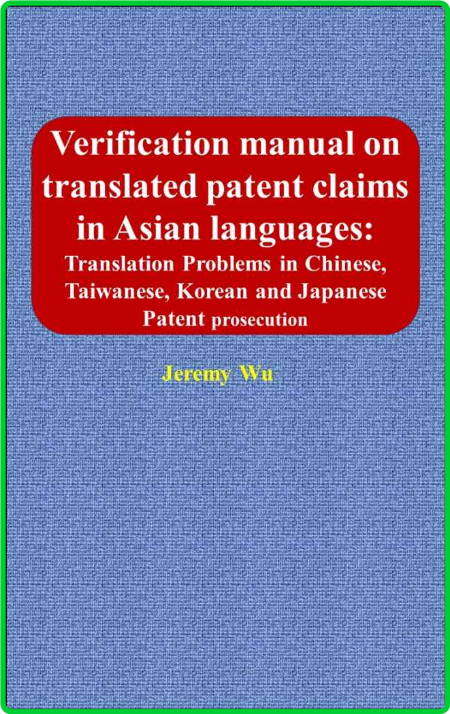 Verification Manual On Translated Patent Claims In Asian Languages - Translation P...
Verification Manual On Translated Patent Claims In Asian Languages - Translation P...
Dom Ago 08, 2021 6:24 pm

[/center]
Verification Manual On Translated Patent Claims In Asian Languages - Translation Problems In Chinese, Taiwanese, Korean
pdf, epub, azw3, mobi | 2.99 MB | English | Isbn: B09BQDK2JN | Author: Wu, Jeremy | Year: 2021
[/center]
Description:
This book is the international English edition, revised and enlarged, of" a concise manual for the verification of translated patent claims in US, China, Taiwan and Korea", Jeremy Wu.
Because it is a Kindle, if you install it on a smartphone or tablet, you can use it anywhere in the world when traveling!
Packed with know-how to gain the ability to verify translated patent claims in major Asian countries (China, Taiwan, Korea, Japan) and the United States in the least amount of time!
You know "closed language" in the U.S.! Then, do you know expressions that could be interpreted as "closed language" in China, Taiwan, Korea, and Japan?
What is the correct English verb to express circuit connection relations in the digital age? What is the correct translation for such an English verb in China, Taiwan, Korea, and Japan?
Do you understand the difference between "on" and "over" in English? How do you write similar differences in China, Taiwan, Korea, and Japan?
Do you know why "一种X ・・・" at the beginning of the China claim?
Will "2以上" in Chinese include 2? In Taiwanese Chinese, "多個" includes two pieces?
What do "藉" and "將" mean in Taiwanese Chinese?
"More than 2" in English is " 3以上" in Japanese !
Before 2000, companies mainly in Europe, the United States, and Japan dominated high-tech technology. Therefore, disputes between companies regarding patents in Asian countries were argued based on the English translation of claims (That is, the original English claims). Therefore, it was not a question of whether the claims in each country's language were accurate.
However, especially since 2010, high-tech companies in Asian countries have surpassed Europe, the United States, and Japan in some technologies. As a result, when a patent in those countries becomes a problem, the accuracy of the claims in the language of the country in question has become important.
For this reason, patent staff members in Europe, the United States, and Asian countries, that is, in-house patent staff members, patent attorneys and lawyers in charge of prosecuting applications for the companies, are also considered essential to have the ability to verify claims in Asian countries. Therefore, guidelines such as this book are required as the first step in gaining claim verification capabilities in Asian countries.
The purpose of this book is to speed up the learning process to verify whether claims translated from their home language to other languages are translated correctly when filing patent applications in China, Taiwan, Korea, and Japan. Provided that you have basic knowledge on the written language in question, we assume 3 months on Korean, 6 months on Chinese and Taiwanese Chinese, and 3 months on Japanese.
In general, it is believed that the verification of a translated patent claim is most accurate, by the person in charge of the application who is native to the original language (the first language). For example, many companies verify U.S. claims by the person in charge of the application or the domestic attorney in charge.
Conventionally, we have asked claims translation checkers or local attorneys in the target language (the second language) of translated claims who are second language natives and can understand the first language. However, native speakers of these second languages share the same mistranslation tendencies as the translators (machine translation, PC translation, web translation) of the application, and it is often thought that there is not much meaning in requesting them to verify translated claims.
Hosters: Rapidgator |Nitroflare
https://rapidgator.net/file/0ec52614fa4765e4a3f02b9d77868ca6/143xp7api8t7.rar
[/center]
https://nitro.download/view/BFA6C4865359581/80z2q1ys54li.rar
- Sensitive Reading - The Pleasures of South Asian Literature in Translation
- Patent It Yourself: Your Step-by-Step Guide to Filing at the U.S. Patent Office - ...
- Patent It Yourself: Your Step-by-Step Guide to Filing at the U.S. Patent Office - ...
- Patent It Yourself: Your Step-by-Step Guide to Filing at the U.S. Patent Office - ...
- Patent It Yourself: Your Step-by-Step Guide to Filing at the U.S. Patent Office - ...
Permisos de este foro:
No puedes responder a temas en este foro.


